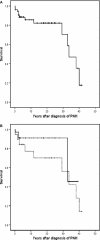Paroxysmal nocturnal hemoglobinuria: a single Spanish center's experience over the last 40 yr
- PMID: 24758317
- PMCID: PMC4232878
- DOI: 10.1111/ejh.12346
Paroxysmal nocturnal hemoglobinuria: a single Spanish center's experience over the last 40 yr
Abstract
Paroxysmal nocturnal hemoglobinuria (PNH) is a rare clonal disease. To date, many reviews and series have been described. We report the experience of our center by presenting a review of 56 PNH patient cases with an average age at diagnosis of 38 yr and follow-ups beginning at approximately 40 yr; the median survival rate was 11 yr. The average clonal size upon diagnosis was 48%, presenting a variable evolution. Thrombotic episodes and cancer were five each, and the main causes of death among our patients were equal at 8.9%. Radiological study by magnetic resonance imaging is presented as a fundamental technique for estimating the deposit of iron levels in the liver and kidney, as well as in some decisive cases at the start of eculizumab therapy. Sixteen patients have been treated with eculizumab so far in our series, and being a safe drug, it provides improvement in the patients' quality of life, and the disappearance of clinical symptoms, and avoids the emergence of new thrombosis.
Keywords: eculizumab; liver transplantation; paroxysmal nocturnal hemoglobinuria; secondary cancer; thrombosis.
© 2014 John Wiley & Sons A/S. Published by John Wiley & Sons Ltd.
Figures


Similar articles
-
Distinct clinical characteristics of paroxysmal nocturnal hemoglobinuria in patients in Southern Taiwan: A multicenter investigation.Kaohsiung J Med Sci. 2017 Aug;33(8):405-410. doi: 10.1016/j.kjms.2017.05.011. Epub 2017 Jul 2. Kaohsiung J Med Sci. 2017. PMID: 28811010 Free PMC article.
-
Hematopoietic Cell Transplantation for Paroxysmal Nocturnal Hemoglobinuria in the Age of Eculizumab.Biol Blood Marrow Transplant. 2019 Jul;25(7):1331-1339. doi: 10.1016/j.bbmt.2019.01.033. Epub 2019 Feb 1. Biol Blood Marrow Transplant. 2019. PMID: 30711779 Free PMC article. Clinical Trial.
-
[Advancements in diagnosis and management of paroxysmal nocturnal hemoglobinuria - review].Zhongguo Shi Yan Xue Ye Xue Za Zhi. 2012 Oct;20(5):1267-71. Zhongguo Shi Yan Xue Ye Xue Za Zhi. 2012. PMID: 23114162 Review. Chinese.
-
A retrospective study of paroxysmal nocturnal hemoglobinuria in pediatric and adolescent patients.Blood Cells Mol Dis. 2017 May;64:45-50. doi: 10.1016/j.bcmd.2017.03.006. Epub 2017 Mar 18. Blood Cells Mol Dis. 2017. PMID: 28380398
-
[Paroxysmal nocturnal hemoglobinuria and thrombosis in the era of eculizumab].Rinsho Ketsueki. 2018;59(8):1042-1047. doi: 10.11406/rinketsu.59.1042. Rinsho Ketsueki. 2018. PMID: 30185704 Review. Japanese.
Cited by
-
The Inhibition of Complement System in Formal and Emerging Indications: Results from Parallel One-Stage Pairwise and Network Meta-Analyses of Clinical Trials and Real-Life Data Studies.Biomedicines. 2020 Sep 16;8(9):355. doi: 10.3390/biomedicines8090355. Biomedicines. 2020. PMID: 32948059 Free PMC article.
-
The Extended Use of Eculizumab in Pregnancy and Complement Activation⁻Associated Diseases Affecting Maternal, Fetal and Neonatal Kidneys-The Future Is Now?J Clin Med. 2019 Mar 24;8(3):407. doi: 10.3390/jcm8030407. J Clin Med. 2019. PMID: 30909646 Free PMC article. Review.
-
Early Mortality in Paroxysmal Nocturnal Hemoglobinuria.Cureus. 2023 Oct 17;15(10):e47225. doi: 10.7759/cureus.47225. eCollection 2023 Oct. Cureus. 2023. PMID: 38022316 Free PMC article.
-
Distinct clinical characteristics of paroxysmal nocturnal hemoglobinuria in patients in Southern Taiwan: A multicenter investigation.Kaohsiung J Med Sci. 2017 Aug;33(8):405-410. doi: 10.1016/j.kjms.2017.05.011. Epub 2017 Jul 2. Kaohsiung J Med Sci. 2017. PMID: 28811010 Free PMC article.
-
[The preliminary research in paroxysmal nocturnal hemoglobinuria with thrombosis].Zhonghua Xue Ye Xue Za Zhi. 2016 Apr;37(4):318-23. doi: 10.3760/cma.j.issn.0253-2727.2016.04.014. Zhonghua Xue Ye Xue Za Zhi. 2016. PMID: 27093996 Free PMC article. Chinese.
References
-
- Rosse WF. Epidemiology of PNH. Lancet. 1996;348:560. - PubMed
-
- Takeda J, Miyata T, Kawagoe K, Iida Y, Endo Y, Fujita T, Takahashi M, Kitani T, Kinoshita T. Deficiency of the GPI anchor caused by a somatic mutation of the PIG-A gene in paroxysmal nocturnal hemoglobinuria. Cell. 1993;73:703–11. - PubMed
-
- Krawitz PM, Höchsmann B, Murakami Y, et al. A case of paroxysmal nocturnal hemoglobinuria caused by a germline mutation and a somatic mutation in PIGT. Blood. 2013;122:1312–5. - PubMed
-
- Hill A, Kelly RJ, Hillmen P. Thrombosis in paroxysmal nocturnal hemoglobinuria. Blood. 2013;121:4985–96. - PubMed
MeSH terms
Substances
LinkOut - more resources
Full Text Sources
Other Literature Sources

